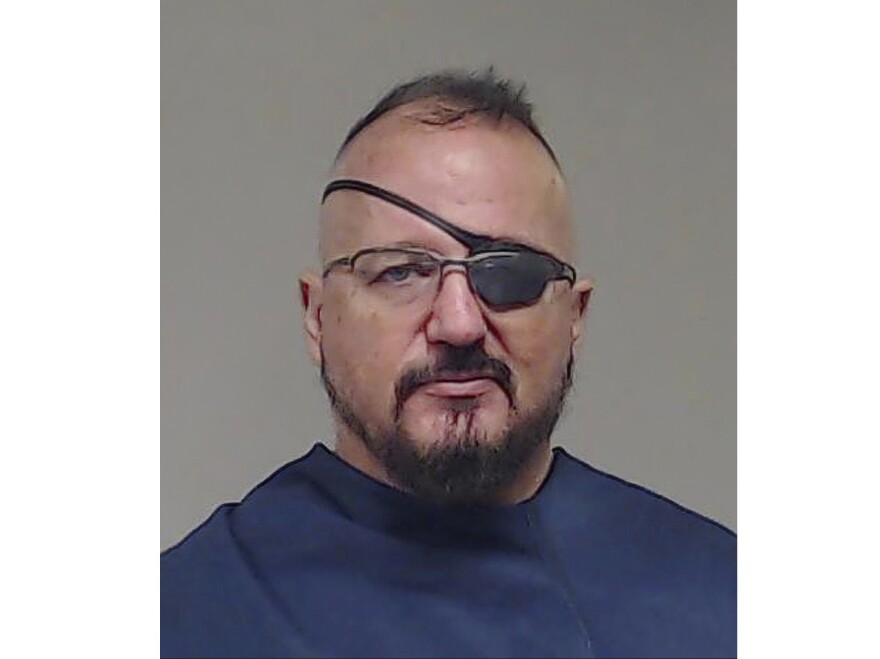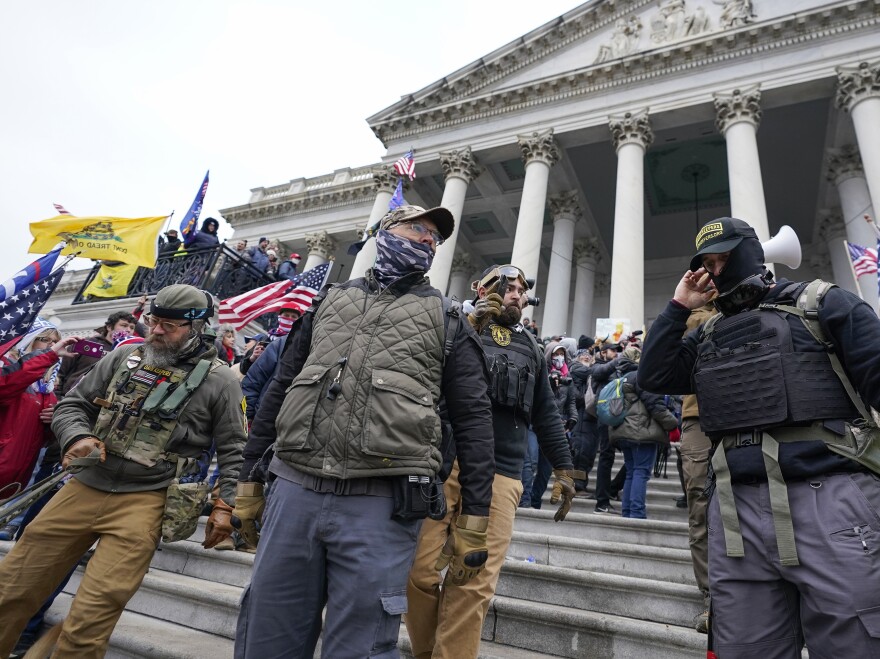The first significant legal skirmish in the biggest case so far to emerge from the investigation into the Jan. 6 attack on the U.S. Capitol went to the Justice Department.
Last week, a magistrate judge in Texas ordered that the founder of the Oath Keepers extremist group, Stewart Rhodes, remain in jail pending trial. Rhodes and 10 others are charged with seditious conspiracy for allegedly plotting to prevent by force the transfer of presidential power to Joe Biden.
The bigger legal battle lies ahead as prosecutors seek to prove their case and the central charge of seditious conspiracy.
That charge carries both symbolic and political weight — at root, it's alleging an attack on the country. It also pushes back against the notion, still popular among many supporters of former President Donald Trump, that the deadly assault on the Capitol was little more than a rowdy protest.
The government has used the charge sparingly since the statute was enacted in the 19th century. In the past four decades, the Justice Department has brought around a half dozen seditious conspiracy cases, and those prosecutions have ended with mixed results.
"The idea of being branded a traitor to your country, of committing sedition, stands out," said Joshua Braver, a law professor at the University of Wisconsin. "It sends a certain political message."
Federal code defines seditious conspiracy as two or more people conspiring to overthrow or destroy by force the United States government, or to prevent, hinder or delay the execution of any U.S. law.
The statute dates back to the Civil War-era, Braver said, when it was enacted as a way to prosecute secessionists, although it has been used sparingly over the years.

The last seditious conspiracy case: the Hutaree militia
The last time federal prosecutors pursued seditious conspiracy charges was in 2010 against members of the far-right Hutaree militia in Michigan. The government accused the Hutaree of plotting to kill police officers and then bomb the funerals to try to spark a civil war.
The defense said the alleged conspiracy was nothing more than hot talk.
"They were in the woods. They were training. They had no plan," said William Swor, who was the attorney for the lead defendant in the case. "Their plan was to be ready when the apocalypse came and the forces of the antichrist invaded America."
At trial, prosecutors played snippets of conversations recorded by an informant suggesting the Hutaree were plotting violence. But on cross examination Swor said he was able to show that those snippets were incomplete or taken out of context when the defendants were "clearly clowning around."
"You've heard that there was this plot to kill a police officer and then ambush the mourners when they came?" Swor said. "What you didn't hear was during that same conversation, some of the younger members of the Hutaree talking about bringing strippers."
"The Hutaree neither had the means nor made any attempt to move against government," Swor said.

Ultimately, the court agreed. The judge dismissed the case after finding that there was insufficient evidence of a conspiracy.
Barbara McQuade, who was the U.S. attorney in Detroit at the time, said the failure of the case against of the Hutaree was not because of any fault with the law.
"In our case, the defendants were arrested before the attack, and that allowed them to say 'we weren't really serious,' " McQuade said.
One of the obstacles the prosecution ran into was the gravity of the charge itself, she said.
"There's sort of a gut reaction that comes with a charge of seditious conspiracy, that this is something more than just a garden variety type of crime. This is an attack on our country," McQuade said.
That sort of gut reaction, she said, may have been missing from the Hutaree case.
Many people may experience "the utter disbelief that we have that there can be people who want to overthrow our government or think that they could possibly be successful," she said.
Two seditious conspiracy cases in the late 1980s, including one in Arkansas against White Supremacists, also ended in losses for the government. But prosecutors used the statute to convict Sheik Omar Abdel Rahman and several of his followers in 1995 of plotting attacks in New York.

Planting hundreds of bombs across New York in a textbook case
Technically, there's no requirement that conspirators do anything illegal in furtherance of their plot, but overt acts make it easier for the government to prove its case to a jury.
Take the 1981 prosecution against members of the FALN, a Puerto Rican nationalist group.
"They built and planted something like 128 or so bombs, killing a number of people, wounding scores of people, maiming many, including New York City police officers," said Jeremy Margolis, who was one of the lead prosecutors.
The government's case was rooted in a series of communiques the FALN released claiming responsibility for the bombings and explaining why they had carried them out.
"How often do you have somebody put a bomb in a New York restaurant, the Fraunces Tavern, at lunchtime, killing four and wounding 56 and then planting a communique saying, 'Free Puerto Rico, that's why we did this,' " Margolis said.

It was a textbook case of seditious conspiracy, he said.
"They wanted to change the way the government of the United States functions and acts," he said. "And because the statute very, very clearly tracked what they were doing and in fact, what these anonymous FALN communiques said they were doing and why they were doing it, it was an easier case to prove."
At trial, the FALN defendants refused to recognize the court's jurisdiction and did not mount a defense, Margolis said. They were found guilty and sentenced to lengthy terms in prison.
Using text messages and the scene of the crime to make a case against the Oath Keepers

As for the Capitol riot seditious conspiracy case, the Justice Department alleges that 11 members of the Oath Keepers, including its founder Rhodes, of plotting to use force to prevent the transition of presidential power to Biden.
According to the indictment, the defendants spent months after the election recruiting, training and conspiring to forcefully disrupt the certification of Biden's election win.
Several of the Oath Keeper defendants stormed the Capitol on Jan. 6. Court papers say the group also had weapons stashed at a hotel nearby in Virginia and a quick reaction force ready to ferry them into Washington, D.C., if Rhodes gave the order.
McQuade said the evidence put forward in the indictment, including text messages the defendants allegedly sent each other planning their course of actions, suggest the government has a strong case.
"It is very clear that the target is the United States government, that they were attempting to stop the transition of power," she said. "They say so themselves, and there they are, right at the scene, at the seat of government in the People's House."
All 11 defendants have pleaded not guilty and are fighting the charges. They are slated to go on trial in the summer.
Copyright 2023 NPR. To see more, visit https://www.npr.org.



